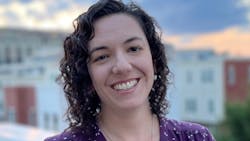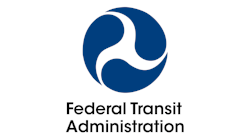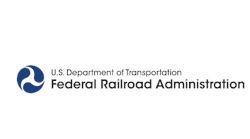One word to describe yourself: Dedicated
Alma Mater: The George Washington University (bachelor’s and master’s)
Fun fact about yourself: I’m right-handed even though both of my parents are lefties.
Favorite station or stop that you have ever visited or frequent (and why): Toledo Station in Naples, Italy. I’ve only been there once but it is known around the world for how beautiful of a station it is, even winning an award for the most beautiful transit station in Europe. The station incorporates both contemporary art that symbolizes different periods in Naples’ history, as well as ancient art and mosaics to pay homage to Naples’ ancient history. The contemporary art plays with light and color that changes as you descend underground. It certainly was deserving of the most beautiful station award.
Favorite route you have ever ridden or frequent (and why): Vienna Tram Line D to the urban winery hill in Vienna, Austria. It’s an old tram that runs through some lovely neighborhoods on the way to a bus that takes you to the only urban area in the world that has working wineries. Once you get to the top of the hill, where the view of the city is breathtaking on a clear day, you can walk down the hill, visit wineries and pick up the tram back to the city center when you are done.
Adrianne R. Malasky’s transportation influence started early when she was growing up in Boston, Mass., on a street that hosted the Green Line T Trolley. As she became older and her transportation interest evolved, she pursued public policy, which led to roles within the Federal Transit Administration (FTA) and Federal Railroad Administration (FRA).
Malasky is described as a respected leader and strong influence in national and international transportation policy. She began her career in transportation as a policy analyst in FTA’s Office of Safety, where she served as one of the lead drafters of FTA’s core safety regulation—the Public Transportation Agency Safety Plan Rule. In this role, Malasky spearheaded the agency’s efforts to bring an innovative Safety Management Systems approach to the transit industry.
After successfully publishing the final rule, Malasky served as FTA’s Acting Division Chief for Safety Risk Management and Assurance. She led FTA’s strategic planning efforts in the safety arena, helping to develop new technical assistance tools, guidance and a long-range vision for transit safety across the nation. Malasky’s efforts with strategic planning and rulemaking helped establish a new line of business for FTA as a direct safety regulator when, historically, the agency served primarily as a grant-making agency.
Her work has helped curb safety incidents and events around the country. In 2019, Malasky’s work with transit policy propelled her into a new position with FTA—the director of the Office of Research Management, Innovation, and Outreach. In this role, Malasky managed a team leading a number of strategic programs and initiatives for FTA, including congressional reports development, research marketing and outreach, external research through the Transportation Research Board’s Transit Cooperative Research Program and FTA’s international research program.
Throughout the pandemic, Malasky’s team supported frontline workers in the transit industry, most notably with the development and successful implementation of the first ever Transit Frontline Workforce Technical Assistance Center. Malasky oversaw this $5 million effort to support the recruitment, retention, training and upskilling of transit frontline workers throughout the national transit driver shortage. She also served a tenure on FTA’s Executive Management Team as the acting deputy associate administrator for research, demonstration, and innovation where she provided executive direction over a cross-disciplined team of 31 professionals and managed a portfolio of $190 million in active transit research, demonstration and innovation efforts. Malasky also led the development of a new marketing and outreach initiative to more effectively share and disseminate research results to FTA’s key stakeholders.
In 2022, Malasky made the leap to rail and her current position as special assistant to the administrator of the FRA, where she assists the administrator with policy and program decisions related to passenger and freight rail across the country and provides her transit expertise to help facilitate better, more climate efficient options for travel across the country.
Malasky’s influence on the transit industry runs deeper than the worthy policy accomplishments under her belt. Malasky is described as a strong advocate for women in transit and transportation in general, serving as a mentor and role model through her work at FTA and FRA. She also chairs the Women in Transportation Group of the Asia Pacific Economic Cooperation, which helps ensure that women in the Pacific region are recognized and included in the transportation industry equitably and safely. She also was the primary author for a research report on pregnant transit riders entitled, “Analysis of Challenges Facing Pregnant Woman Riding Transit.”
In her nomination for the 40 Under 40, she is said to bring “an open mind to problem solving” and succeeds at “creating and maintaining strong relationships.”
Outside the office, Malasky has served as the president of the DC Young Professional Chapter of the American Jewish Committee and served in leadership roles with the Jewish Federation of Greater Washington. She has received numerous awards during her time with FTA, including two Transportation Secretary’s Awards for Safety and several FTA Administrator’s Awards.
Is there a specific experience that led you to where you are today?
I have always been interested in transportation ever since I was a child growing up just outside of Boston, Mass., where the Green Line T Trolley ran right in front of my childhood home, splitting the large street that I grew up on. When I was asked at a young age what I wanted to be when I grew up, I answered that I wanted to be a trolley driver. As I got older, my ambitions changed, but my interest in transportation, specifically in moving people and goods efficiently, effectively, safely, environmentally friendly and for the lowest cost, drove me to study public policy and eventually brought me to USDOT. By finding the right opportunities, I was able to expand my experience moving from transit safety to transit research, then to railroad, where I currently work.
What do you enjoy most about your job?
In my current role as special assistant to the administrator of the FRA, I most enjoy being able to be involved in all aspects of FRA’s work, from policy to climate matters to safety to public affairs and government affairs. I’m able to interact with staff across the agency as well as stakeholders in the industry on all sorts of issues affecting passenger and freight rail. I am also energized by the goals set forth in the Bipartisan Infrastructure Law and what we can do at FRA to help bring passenger rail service to more Americans, providing them with more travel options.
What’s the most challenging part of your job?
As a new employee to a new mode at USDOT, the most challenging part of my current job is learning about a new mode. I had some visibility into passenger rail issues from my time at FTA, but I had no exposure to freight rail issues. Considering that transit is a public entity in the United States, but rail is mostly private also presents a new wrinkle and angle to figure out, especially the politics and negotiations between Amtrak and the freight railroads that own the tracks. I still have a lot to learn, but learning keeps me going and keeps the job interesting.
Accomplishment you’re most proud of and why?
Professionally, I am most proud of getting the Public Transportation Agency Safety Plans Final Rule (49 CFR Part 673) published and then implemented. As a transportation public policy professional, to get a regulation published was a huge accomplishment, but this regulation also ushered in a new era of safety in the public transportation industry. This was a big accomplishment with lasting benefits for not only public transportation agencies, but for all of their customers and stakeholders as well.
Best advice/tip/best practice to share from your area of expertise?
I have spent most of my career thus far in the federal government and I consider myself a generalist, someone who has strong skills that can be applied to any topic area. I’m often asked both how to break into the federal government (it’s a numbers game, you have to apply for many jobs before one will come your way), but also how I’ve been able to advance within the federal government. My advice is always to take the opportunities that feel right to you and to put yourself out there to have those opportunities come your way. I don’t believe in always saying “yes,” some things will not feel right or will not help you advance in your career. The federal government actually provides a lot of opportunities, but you may have to seek them out. Also, don’t be afraid to apply for a position that you think is being held for someone else, you never know what their plans are. Throw your hat in the ring, you never know what might happen.





